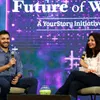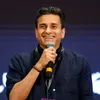Future of Work 2020: Meeta Malhotra, Founder of The Hard Copy, decodes the business of design
Meeta Malhotra, the Founder of The Hard Copy – an online publication focussed on design, technology, and innovation in India – talks about the power of storytelling in the business context.
To an audience packed with product managers and designers at the third edition of YourStory's Future of Work, The Hard Copy Founder Meeta Malhotra threw a question that got the entire room thinking.
She asked, “Whenever you are presenting a product feature or any new piece of design, who decides whether it is good or bad? Who evaluates the design and says – ‘hey this design is good', or this product feature is good or is not good?”
Meeta, currently at the helm of The Hard Copy – an online publication focused on design, technology, and innovation in India – is also an active angel investor and advisor with Kstart, Kalaari Capital’s seed stage fund. She shared the above problem statement as she kickstarted her workshop on the ‘Business of Design’.

The Hard Copy Founder Meeta Malhotra
As someone who has worked with marquee names such as Airtel, Kotak Bank, Mother Dairy, Titan, Arvind, Fortis, Max, Aditya Birla Capital, and Vistara Airlines, helping them create a brand language, Meeta is known for her expertise in brand, design, and technology.
Her problem statement – which evoked mixed responses from the crowd – was a step towards decoding the missing piece that ensures a certain design or a product feature goes through all the checks before reaching the user.
What’s the missing piece?
“Think about the last time you presented a piece of work to your leadership, and they said ‘No, sorry. We don't think this is going ahead. We don't think it's a good idea.’ What do you think is that missing piece that you're lacking right now?”
This scenario presented by Meeta was met with enthusiastic responses from the audience. While someone in the audience said the missing piece was ‘convincing skills’, someone else said it was ‘articulation of idea’. Other responses included, ‘conviction in the design’ and ‘being on the same page as the company value’.
But all these different factors, Meeta explained, are a part of a larger universe, called storytelling.
“I've worked with a lot of designers, product people, senior global leaders around the world,” she says. “And the ones who are really good, the ones who are really inspiring, are not just good at their craft. They're very good at storytelling.”
According to the branding expert, a compelling storyline can play an effective role in conveying a certain product feature or design to the people.
Applying the art of storytelling
That storytelling can be a useful tool in convincing the audience, is almost universal knowledge. But during the workshop, Meeta condensed this tool’s application in the business domain, and discussed how every story has three essential parts – the audience, the cast, and the director.
Explaining this further, the brand and design expert decoded the first component, the audience. At the end of any storytelling (particularly in the business context), the goal should be to take the audience through a journey where their stress levels have gone down and their happiness quotient has increased, she said.
Meeta explained that when one goes into a business presentation and frames the interaction as a “problem to be solved”, then regardless of other factors, for the person at the opposite end, the stress level begins to rise. The solution to this is pretty simple – instead of emphasising the problems, emphasise the possibilities, she said.
“Don't start with a long list of problems. Start with what the possibilities could be. It's a very, very simple switch,” she explained, urging to apply this same theory when pitching a product or a design.
Adapting the Karpman drama triangle
The other, and perhaps more integral component of the tool of storytelling in business context, is the cast. To explain this further, Meeta took the help of the Karpman drama triangle.
It is a social model, which she adapted for the creative community during the workshop, to explain how presentations can be better framed so that designers have the maximum influence on the end result. As part of this, every cast includes one hero, a villain, and the victim.
Meeta used this hero-villain-victim theory to explain how storytelling can be utilised to better present new product features and designs to the leadership, in the process, ensuring that the final product reaches the users.
She left the audience with this parting thought:
“Remember that you, yourself have to develop the influence and the credibility that your leadership is going to listen to. Without that, all the favour in the world is not going to matter.”
(Edited by Ramarko Sengupta)
A big shout out to our Future of Work 2020 Sponsors: Alibaba Cloud, Larksuite, Vodafone Idea Limited, Gojek, Adobe, Udaan, Pocket Aces, Junglee Games, ShareChat, Open, Vesta Space Technology, Maharashtra State Innovation Society, Kristal.AI and GetToWork; and our Knowledge Partner: Ascend Harvard Business Review.











